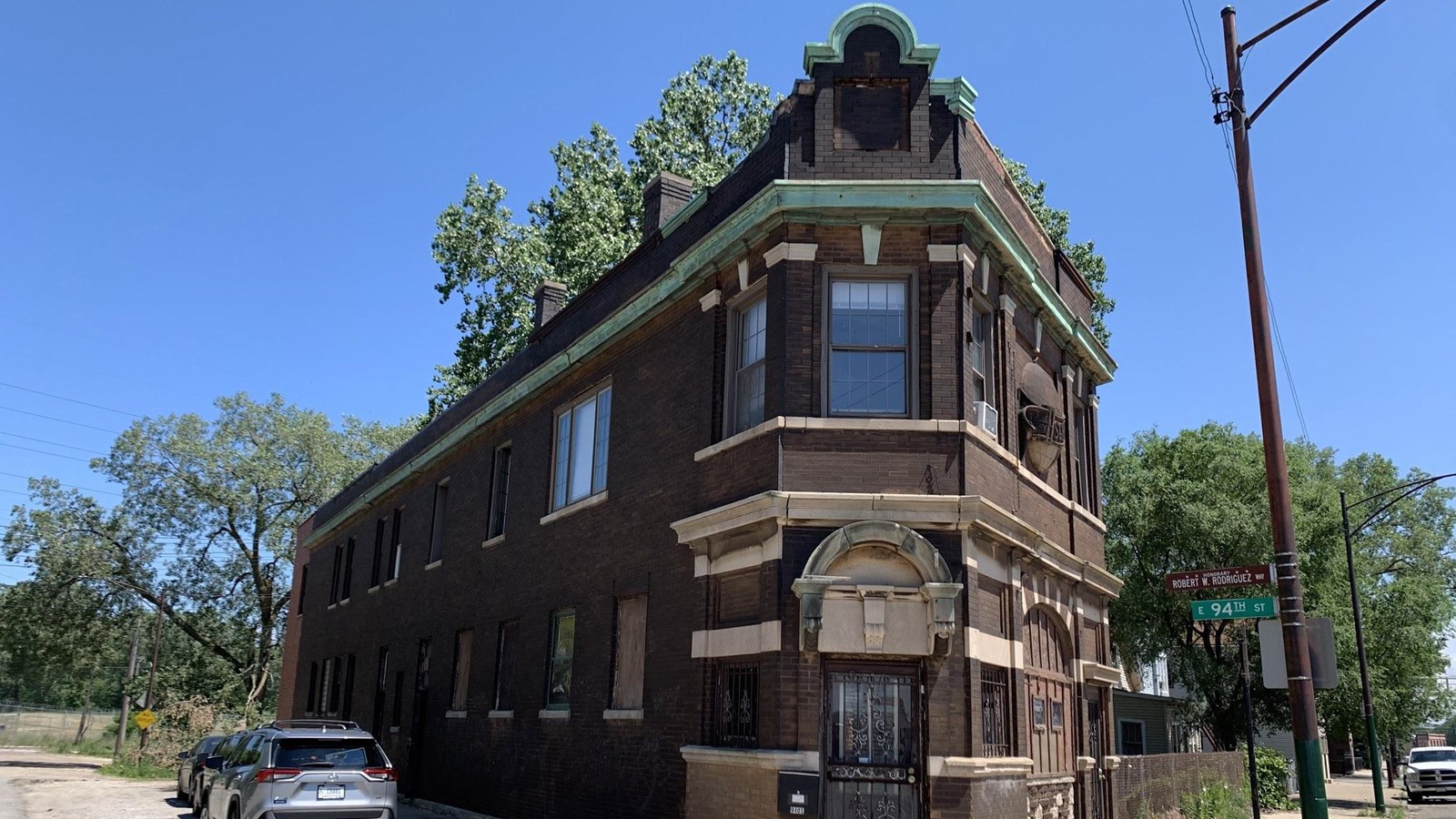Last updated: April 28, 2023
Place
Schlitz Brewery-Tied House

Photograph by Elizabeth Blasius, Jonathan Solomon, Mike Medina, courtesy of Illinois SHPO
Quick Facts
Location:
9401 South Ewing Ave. Chicago, Illinois
Significance:
Architecture
Designation:
Listed in the National Register – Reference number 100008489
OPEN TO PUBLIC:
No
MANAGED BY:
The Schlitz Brewery-Tied House, at 9401 South Ewing Avenue in Chicago, is a two-story brick brewery-tied house, consisting of a first floor tavern and second floor boarding house rooms. It is located within the commercial corridor of South Ewing Avenue in the East Side neighborhood, on the far Southeast Side of Chicago, Illinois. The building was commissioned by Edward Uihlein, manager of Schlitz brewery operations in Chicago, and designed by architect Charles Thisslow in 1907, with additions designed by William C. Presto in the 1930s. The Schlitz Brewery-Tied House conveys the Milwaukee-based Joseph Schlitz Brewing Companies’ deployment of European-influenced architectural styles to communicate the decency of neighborhood saloons/taverns against rising social opposition to alcohol consumption, and to attract European immigrants in Chicago to their saloons/taverns, and therefore their products.
Brewing in Chicago began with the arrival of William Haas and Andrew Sulzer from Watertown, New York, establishing the city's first brewery in 1833. Subsequent breweries would take advantage of Chicago’s location, in proximity to both natural resources and a central market where grain harvested in the Midwest provided brewers access to barley, a key ingredient in beer. In addition to the issuance of subsidies to pay for licenses, brewery salesmen used aggressive sale strategies to ensure that they could secure orders from saloon owners, including undercutting wholesale prices, and providing saloon owners with complementary branded items that the saloon keeper would have otherwise needed to buy themselves, including signage, lighting, glassware, and furniture. Brewers soon established their own management systems for taverns and saloons that were “tied” to the brand, including renting commercial property, and designing, developing, and building taverns of their own.
In the late nineteenth and early twentieth centuries, a combination of intense competition among brewing companies and increasing legal restrictions and social pressures on public drinking establishments compelled brewing companies in Chicago to adopt the "tied house" system. The origins of the "tied house" in America can be traced back to the United Kingdom, when commercial breweries consolidated retail outlets by purchasing or controlling pubs, with "tied house" referred to when a brewery owned a tavern. The tied House came to Chicago in 1892, when the Chicago Brewing & Malting Company and the Milwaukee & Chicago Breweries Ltd. began buying existing saloons and acquiring land to build taverns on. The form of the tied house is based on a simple “store and flat” building, with the public/retail space on the first floor, and private/residential space on the second or even third or fourth story. While there were many brewing companies working under this model, including: Pabst; Miller; Blats; and smaller brewers like Atlas; Birk Brothers; Gottfried; Peter Hand; Stege; and Standard, the Schlitz Brewing Company was the most prolific in terms of product success and public prominence.
The Schlitz Brewery-Tied House has had many iterations and names under independent ownership, which began after national Prohibition in 1919 legislated the tied house system out of existence. These names include, in chronological order, the Dumbell (or Dumbell Tavern) Joy Tavern, the Gay Tavern, Club Selo, The Sun Dodgers Club, Mike’s Club, Club Jo Jo, and JB’s Bamboo Lounge, or the Bamboo Lounge in its later years. The property was purchased in 2019 with plans to reopen.
Brewing in Chicago began with the arrival of William Haas and Andrew Sulzer from Watertown, New York, establishing the city's first brewery in 1833. Subsequent breweries would take advantage of Chicago’s location, in proximity to both natural resources and a central market where grain harvested in the Midwest provided brewers access to barley, a key ingredient in beer. In addition to the issuance of subsidies to pay for licenses, brewery salesmen used aggressive sale strategies to ensure that they could secure orders from saloon owners, including undercutting wholesale prices, and providing saloon owners with complementary branded items that the saloon keeper would have otherwise needed to buy themselves, including signage, lighting, glassware, and furniture. Brewers soon established their own management systems for taverns and saloons that were “tied” to the brand, including renting commercial property, and designing, developing, and building taverns of their own.
In the late nineteenth and early twentieth centuries, a combination of intense competition among brewing companies and increasing legal restrictions and social pressures on public drinking establishments compelled brewing companies in Chicago to adopt the "tied house" system. The origins of the "tied house" in America can be traced back to the United Kingdom, when commercial breweries consolidated retail outlets by purchasing or controlling pubs, with "tied house" referred to when a brewery owned a tavern. The tied House came to Chicago in 1892, when the Chicago Brewing & Malting Company and the Milwaukee & Chicago Breweries Ltd. began buying existing saloons and acquiring land to build taverns on. The form of the tied house is based on a simple “store and flat” building, with the public/retail space on the first floor, and private/residential space on the second or even third or fourth story. While there were many brewing companies working under this model, including: Pabst; Miller; Blats; and smaller brewers like Atlas; Birk Brothers; Gottfried; Peter Hand; Stege; and Standard, the Schlitz Brewing Company was the most prolific in terms of product success and public prominence.
The Schlitz Brewery-Tied House has had many iterations and names under independent ownership, which began after national Prohibition in 1919 legislated the tied house system out of existence. These names include, in chronological order, the Dumbell (or Dumbell Tavern) Joy Tavern, the Gay Tavern, Club Selo, The Sun Dodgers Club, Mike’s Club, Club Jo Jo, and JB’s Bamboo Lounge, or the Bamboo Lounge in its later years. The property was purchased in 2019 with plans to reopen.
